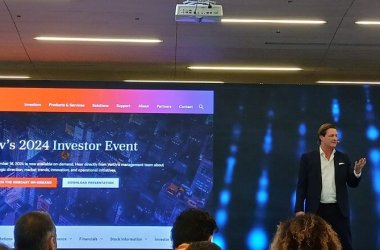CNME Editor Mark Forker spoke to Gary Kazantsev, Head of Quant Technology Strategy at Bloomberg LP, in an effort to find out how Generative AI is transforming the traditional financial landscape, the impact of its BloombergGPT solution – and some of the challenges that exist when it comes to the adoption of Generative AI into existing processes and workflows. 
Can you provide our readers with a broader overview on what your role entails as the Head of Quant Technology Strategy at Bloomberg?
In my role, I sit within our Office of the CTO and set the technology strategy for Bloomberg’s quantitative product portfolio. This means I am responsible for a combination of product development, research, and education.
A large part of that strategy concerns our quantitative research platform – BQuant. I think a lot about what machine learning infrastructure, data, and computational frameworks are needed for the cloud-based analytics we specifically designed for quantitative analysts and data scientists in the financial markets.
To do this, I spend a lot of time talking to our customers and prospects around the globe about their needs. We discuss, for example, how their approaches to investing are becoming more and more data-driven and increasingly make use of statistical and machine learning methods to analyze investment opportunities across a range of asset classes.
Prior to this, I created and led the company’s Machine Learning Engineering group. Starting in 2008, we built the company’s first set of AI projects, the majority of which sit at the intersection of computational linguistics, machine learning, and finance.
These included things like sentiment analysis of financial news, market impact indicators, statistical text classification, social media analytics, question answering, and predictive modeling of financial markets.
The introduction of ChatGPT has really transformed the IT and technology landscape over the last 12 months, but can you tell us more about BloombergGPT – and how its introduction will really impact the financial sector?
As I noted above, Bloomberg has actually been building and using AI in our products for the last 15 years. We use this technology to enable our customers to derive valuable intelligence and actionable insights from our high-quality financial information, not to mention deal with the information overload resulting from continually increasing volumes of financial news and data.
Ultimately, the goal of Bloomberg‘s AI solutions is to enable financial professionals to find what they’re looking for fast in order to make more informed business and investment decisions.
Over the years, we’ve assembled deep experience in the field of AI. Today, Bloomberg employs more than 300 AI researchers and engineers from around the globe, and they are constantly exploring state-of-the-art AI tools and technologies and considering their applications in the financial domain.
But, our AI efforts aren’t only focused on building products. Our AI team also does cutting-edge research, and our researchers have published more than 100 peer-reviewed papers in the last three years.
We also provide funding for research and fellowships, collaborate with academic partners, participate in conferences and program committees, host and mentor interns, and peer-review scientific articles in the fields of natural language processing, information retrieval, and machine learning for major conferences.
Thus, generative AI was not new to us when ChatGPT was introduced – we started investing in the research of generative AI very early on, starting more than three years ago, after the original papers on the GPT architecture were published.
BloombergGPT was the culmination of our initial research efforts in this area. It was the first large language model (LLM) built from scratch that was specifically tailored for the financial domain.
Training this internal, not-for-commercial use model from the ground up – not just fine-tuning another model – showcases our prowess in AI, as well as our commitment to not only using but also creating breakthroughs in this field. We published a very popular research paper about BloombergGPT last March, and it’s been called one of ”Ten Noteworthy AI Research Papers of 2023” by some in the AI field.
So the key thing to understand is that our BloombergGPT research taught us a lot about the capabilities – and limitations – of large language models.
It is informing how we think about applying generative AI to applications in finance – for example, how to enable customers to ask complex questions in natural language and receive insights extracted and developed from potentially millions of structured and unstructured information sources.
Generative AI is a broad field of artificial intelligence that really has the capabilities to change the way businesses operate. However, there are valid concerns over data privacy and security when it comes to Generative AI. What is your view on some of the challenges with Generative AI?
Our research with projects such as BloombergGPT has enabled us to understand both the power and limitations of generative AI, so we can build and employ guardrails when we use this technology in our products.
We are particularly mindful of the limitations of current generative AI technologies and are applying the lessons learned while developing AI systems over the last 15 years to build safeguards that foster accuracy in our AI-enhanced products.
For example, when we summarize a document using generative AI, we link back to the source content to provide full attribution and transparency, so the user can verify the accuracy of the summary.
In addition to the more commonly talked about limitations like hallucinations, or confabulations, generative LLMs are trained on static datasets, and thus cannot access up-to-date information on recent events without access to external knowledge bases or APIs.
They are not capable of reasoning – in particular, reasoning over temporal relations – and lack the capability to perform precise mathematical calculations. They are also very expensive to retrain. As you can imagine, some of these issues are particularly impactful with regards to finance, where it is important to understand the financial performance of a company over time and how that might differ from a previous quarter or year.
Our AI researchers have spent a lot of time learning how to mitigate these constraints using retrieval augmented generation (RAG) and “Toolformer” paradigms to call existing tools — Bloomberg‘s APIs, databases, and the Bloomberg Knowledge Graph — in generating responses to user queries.
In fact, we have been using methods like retrieval augmented generation for quite some time. The question answering system we built to enable Bloomberg Terminal users to interact with Bloomberg systems utilizing natural language makes use of this exact paradigm.
A statistical model is used to convert natural language input into a structured logical representation, which is then converted into API calls, search engine and database queries to perform the retrieval step in a fully deterministic, attributable, and transparent manner.
This system was built before transformers, and the statistical model used is not a generative AI model. We did not know this methodology was called “Retrieval Augmented Generation” when we started building it a decade ago, but the approach is very familiar to us.
Can you provide us with more insights into the evolving role of Machine Learning in finance – and what new trends you expect to see emerge across the financial ecosystem in the next 12 months?
Machine learning is already used across the investment process for a variety of tasks – from security screening and selection to factor construction from unstructured and structured data, as well as from alpha generation to execution.
It helps organizations digest larger and larger datasets. For Bloomberg, this makes it possible to deliver new kinds of products and analytics to our clients. A good example of this is sentiment analysis of news stories and social media, which was the first AI-enhanced product Bloomberg deployed to clients back in 2009.
One consequence of improvements in machine learning techniques and increasing adoption of these methods is the ability for our clients to rapidly digest new sources of information – such as from large datasets like GPS coordinates, social media or pharmaceutical data – and extract signals and value that otherwise would be very difficult, or even impossible, to capture.
Since the introduction of ChatGPT, our clients – indeed the whole world – have acquired more appreciation for what the state of the art in AI and machine learning is, and what we are capable of.
This has served to accelerate the adoption of these technologies, especially as the barriers to entry to use these models have virtually disappeared due to the ease of use of a natural language interface.
Over the next 12 months, I think we can easily anticipate the industry rapidly exploring the capabilities and limitations of this technology and focusing on key use cases to improve efficiency of various automatable or augmentable workflows.
Some examples to look for include reading and summarizing complex documents, improved search and analytics, code generation, and more.
What were some of the major takeaways that jumped out at you during the World Governments Summit in Dubai?
AI was front and center at the World Governments Summit, with sessions and discussions about AI in every forum – covering topics from digital government to innovation, education, ethics, etc. It is clearly an issue which is top of mind for a lot of people, both within the financial sector and outside it.
Many of the conversations concerned limitations of the technology, governance, safety, and responsible AI development.
Another thing that struck me was the overall spirit of optimism about the future. It was very refreshing and inspiring to see people from around the world – both young and old – envisioning a brighter future and working towards it.
The consensus at the Summit pointed to an increased need for collaboration between industry, government, and academia – something we at Bloomberg are fully in agreement with and have been working on for years – to facilitate engagements between various stakeholders across the spectrum.





